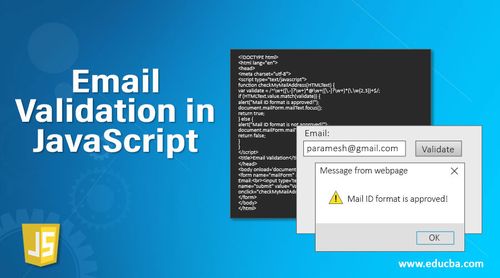Email validation is a fundamental aspect of web development, ensuring that user-provided email addresses are accurate and properly formatted. JavaScript plays a pivotal role in implementing this validation on web forms, but understanding the intricacies of email validation is crucial. In this expert guide, we will unravel the complexities of email validation in JavaScript, providing you with a comprehensive understanding, practical examples, and best practices to create robust email validation scripts.
The Importance of Email Validation
Email validation serves multiple purposes in web development:
Data Accuracy: Valid email addresses ensure that your database contains accurate information.
Enhanced User Experience: Real-time validation provides immediate feedback to users, reducing errors.
Spam Prevention: Validating email addresses helps prevent spam registrations and submissions.
Security: Email validation helps protect your application from malicious input.
Building a Basic Email Validation Script
A basic email validation script typically involves using regular expressions to check if an email address conforms to a standard format. Here's an example of a basic email validation script in JavaScript:
function isValidEmail(email) {
const regex = /^[a-zA-Z0-9._-]+@[a-zA-Z0-9.-]+\.[a-zA-Z]{2,4}$/;
return regex.test(email);
}
This script checks for common email format patterns, including the "@" symbol and a valid domain.
Handling Email Validation Edge Cases
Email validation can become more complex when dealing with edge cases, such as:
Internationalized Email Addresses (IDN):
- Challenge: IDN email addresses contain non-ASCII characters.
- Solution: Use the
punycodelibrary to convert IDN domains to their ASCII representation for validation.
Subaddressing:
- Challenge: Subaddressing allows users to append "+tag" to their email addresses.
- Solution: Modify your validation regex to allow for subaddressing.
Single-Character Local Parts:
- Challenge: Validating single-character local parts requires adjusting regex patterns.
- Solution: Adapt your regex to permit single-character local parts.
Unusual Characters:
- Challenge: Some email addresses may contain unusual characters.
- Solution: Customize your regex to accommodate specific character sets.
Robust Email Validation with Regular Expressions
Regular expressions (regex) are the cornerstone of email validation in JavaScript. Here's a breakdown of the key components of a robust email validation regex:
^[a-zA-Z0-9._-]+: Matches the local part of the email address, allowing letters, numbers, dots, underscores, and hyphens.
@: Ensures the presence of the "@" symbol, a fundamental element of any email address.
[a-zA-Z0-9.-]+: Matches the domain name, permitting letters, numbers, dots, and hyphens.
\.: Requires the presence of a dot (.) in the domain.
[a-zA-Z]{2,4}$: Ensures that the domain ends with a 2 to 4 character top-level domain (TLD).
Implementing Real-Time Validation
Real-time email validation provides instant feedback to users as they type. To implement this feature, use event listeners such as input or change to trigger validation functions. Here's a simplified example using the input event:
const emailInput = document.getElementById('email');
emailInput.addEventListener('input', function () {
const email = emailInput.value;
const isValid = isValidEmail(email);
if (isValid) {
// Display a success message or style the input as valid.
} else {
// Display an error message or style the input as invalid.
}
});
Best Practices for Email Validation in JavaScript
Use Established Libraries: Consider using reputable email validation libraries or services to handle complex edge cases.
Regular Expression Optimization: Regular expressions can be resource-intensive; optimize them for better performance.
Localized Validation: Adapt your validation rules to accommodate email addresses from various regions.
User-Friendly Feedback: Provide clear and concise error messages to guide users in correcting their input.
Test Thoroughly: Test your email validation script with a variety of email addresses, including edge cases.
Common Questions About Email Validation in JavaScript
Is regex the only way to validate emails in JavaScript?
Regex is a common approach, but libraries and services are also available for more comprehensive validation.
Can I use HTML5 input types for email validation?
HTML5 provides an email input type that offers basic validation, but custom JavaScript validation is often necessary for more robust checks.
How can I handle real-time validation without causing performance issues?
Throttle or debounce your validation function to control the frequency of validation checks.
What's the future of email validation in JavaScript?
As web technologies evolve, email validation techniques may also change to adapt to emerging standards.
In conclusion, email validation in JavaScript is a crucial skill for web developers to ensure data accuracy and enhance user experience. By understanding the intricacies of email validation, implementing best practices, and handling edge cases, you can create robust validation scripts that contribute to the success of your web applications.



